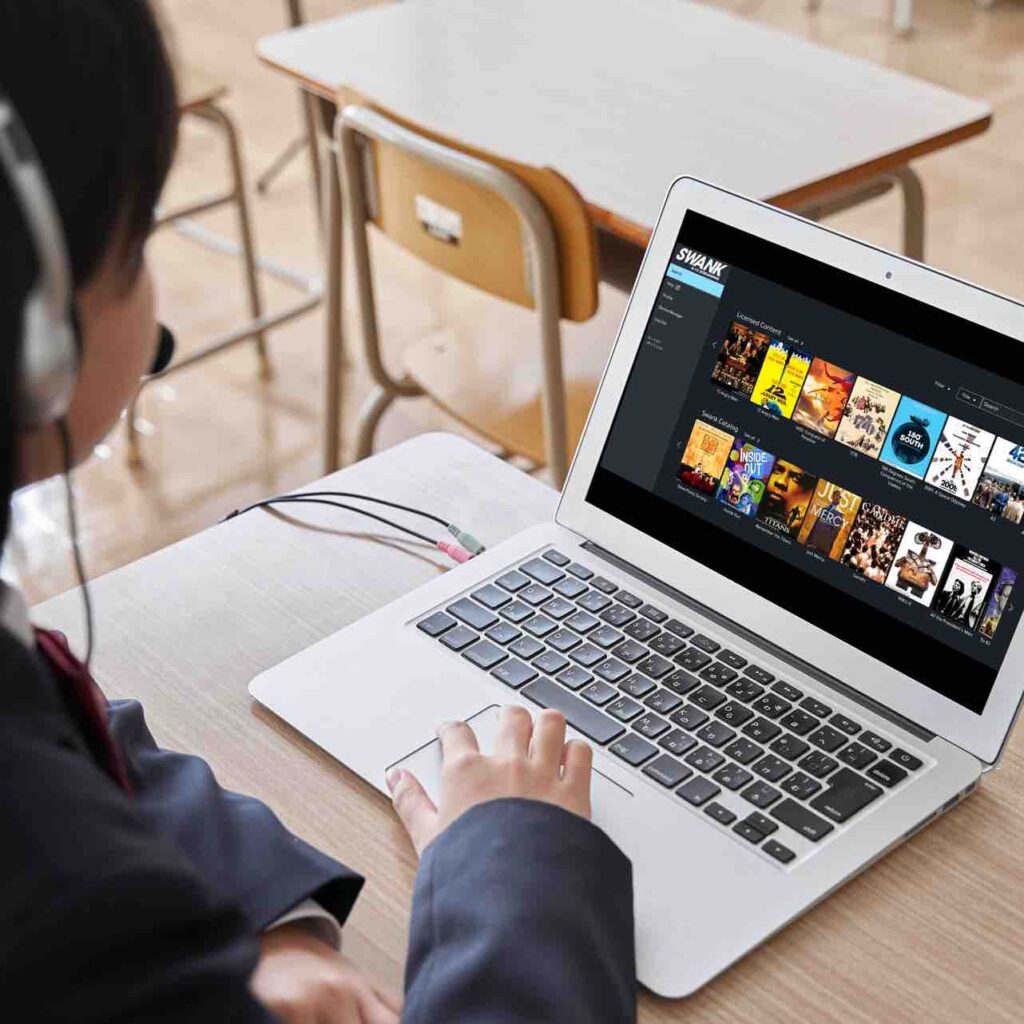Movies can add value to classroom instruction by exploring new topics with students. With feature films, you can bring spaces and periods to life for students. You might incorporate movies into your teaching to support vocabulary instruction, too. Through dialogue, narration, and discussion about what appears on screen, students can see vocabulary words come to life through film across content areas. Teachers can share different historical moments, give students a chance to hear foreign language dialogue, and spark discussion as students compare books to movies citing evidence from the text.

Even if you’re excited about using movies in the classroom, it can be tough to make it happen. There are a few reasons why K-12 teachers might struggle to find an easy way to access films to share with students.
You might remember Swank K-12 Streaming from the feature on the blog last year. I shared how you can create active learning experiences for students using the movies available for streaming on their platform. In today’s blog post, I’ll share three tensions with movie access in schools. Then, we’ll look at how Swank K-12 Streaming addresses these barriers to access.
If you are interested in using movies to supplement instruction, Swank K-12 Streaming has you covered!
DVD Equipment is Less Available
Are you still using DVDs to share favorite movies with students? Although you might have a pile of DVDs that you’ve used in the past to bring the subject matter to life for students, it can be a challenge to find devices at school to play the DVDs. And of course, if you have a great lesson idea that includes a movie or series of movie clips, you might want to tell your colleagues.
However, the logistics of sharing physical DVDs with your colleagues can make it hard to collaborate as a department or grade level team. Streaming movies help address this issue and solve the problem of getting movies into the hands of students who might miss class or participate in a virtual or hybrid model of instruction.
Join the free webinar from Swank K-12 Streaming >>

Personal Streaming Services Can Be Unpredictable
If you’ve encountered issues with DVDs, it’s certainly tempting to use personal streaming sites to show movies in the classroom. Although using a personal login for a streaming service might seem like a quick fix, many schools block these sites. Your school or district might also have policies to prevent teachers from using them.
Personal streaming sites give users access to a wide variety of content – which means inappropriate content is available alongside a film needed for class. The availability of films on these sites can be unpredictable, too. You can avoid these issues by using a K-12 friendly platform, where you also don’t have to worry about a movie disappearing from a particular streaming service.
Not only is this inconvenient, but it also prevents an equitable access point for students outside of the classroom. This obstacle from personal streaming services makes the assignment of movies for homework virtually impossible. Within Swank K-12 Streaming, you can assign movies to students to view. This is something that isn’t possible with personal streaming services.
Additional Issues: Legalities & Lack of Equitable Access for Students Outside of the Classroom
In addition to the two reasons listed above – using DVDs and personal streaming services – another challenge for sharing movies with students are legal issues. Both classroom teachers and media specialists know that it can be tricky navigating the legalities around the use of film at school. Using a platform designed specifically for K-12 schools can help you avoid legal issues.
Additionally, neither DVDs or personal streaming sites can facilitate reliable or equitable student access outside of the classroom. Student access to movies can be helpful for teachers who want to use flipped learning models. It can also be used when you want to provide materials for absent students, for homework, or for students to review class materials on their own time.
New Movie Streaming Platform for K-12 Schools
As I mentioned at the beginning of this post, Swank K-12 Streaming provides a solution to these issues. It gives users access to 30,000 movies and documentaries from all the movie studios. In addition, their safe and legal streaming platform gives you an easy way to get high-quality, vetted resources into the hands of students.

With this controlled access point from Swank K-12 Streaming, teachers can show a film in a classroom setting. Or they can assign specific films to students to watch outside of the classroom. As a result, educators have the control and flexibility to use movies in their lessons effectively.
You can also facilitate equitable access outside of the classroom for students. Students can access movies you share with them, whether or not they have access to personal streaming services at home.
How Movies Can Support Curriculum
Swank K-12 Streaming gives teachers access to movies they can use to support their curriculum. For example, suppose you teach science or want to incorporate social-emotional learning into classroom conversations. In that case, films such as Inside Out or Wall-E might be a good choice for your group. In a social studies classroom, historical movies like Just Mercy, Schindler’s List, and Harriet might be ones you choose to share.
And of course, in an English Language Arts classroom, films with a connection to literature like The Great Gatsby or Of Mice and Men or Romeo & Juliet could help students visualize stories. For foreign language classes, students can greatly benefit from hearing the accents and dialogues along with English subtitles. They can also see new cultural traditions.
Ready to get started? Head over to Swank K-12 Streaming’s website to learn more about this powerful platform. Or join the team for a special webinar this month. During the webinar you can learn all about Swank K-12 Streaming and how to use it in your school or district.







